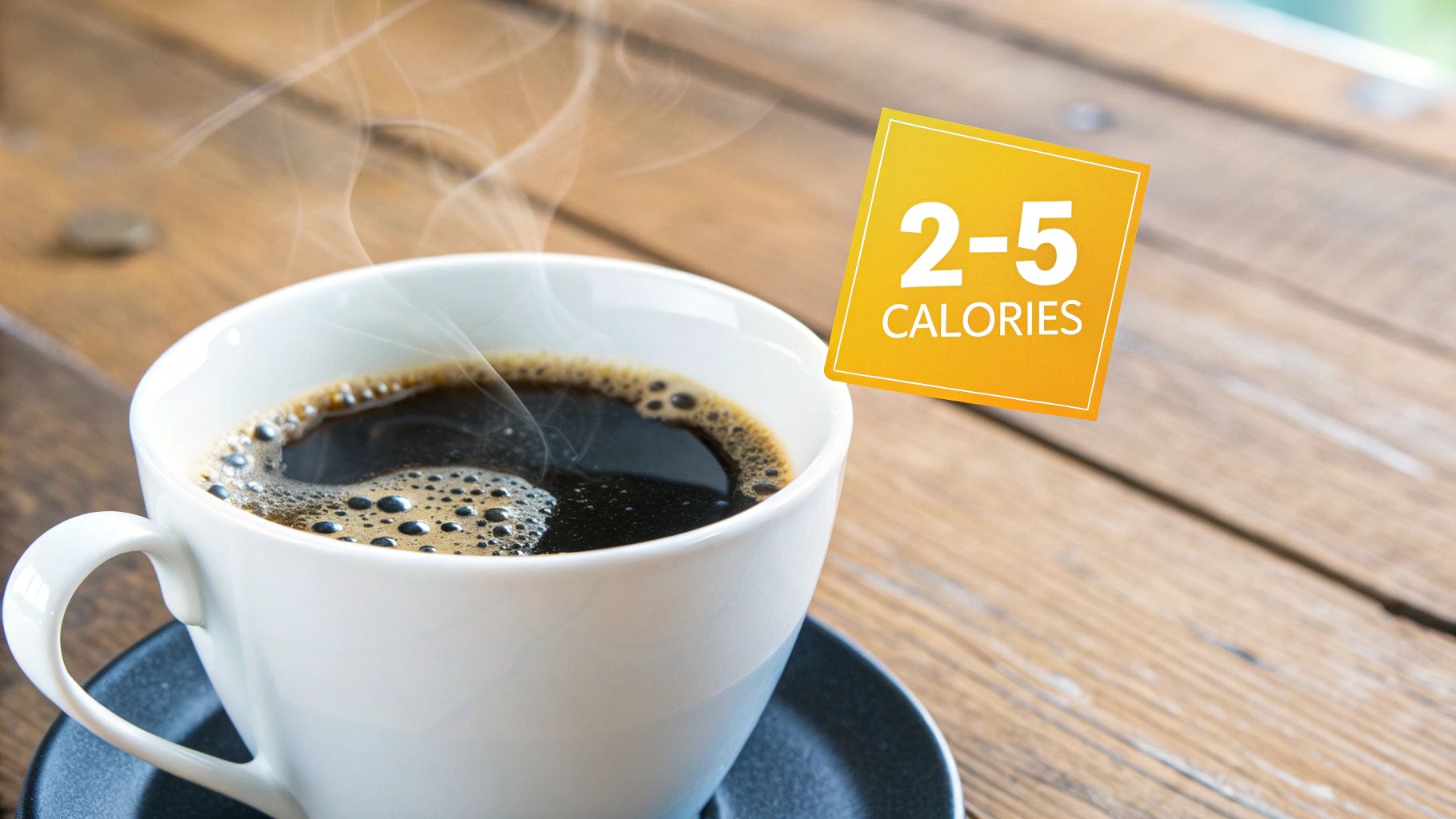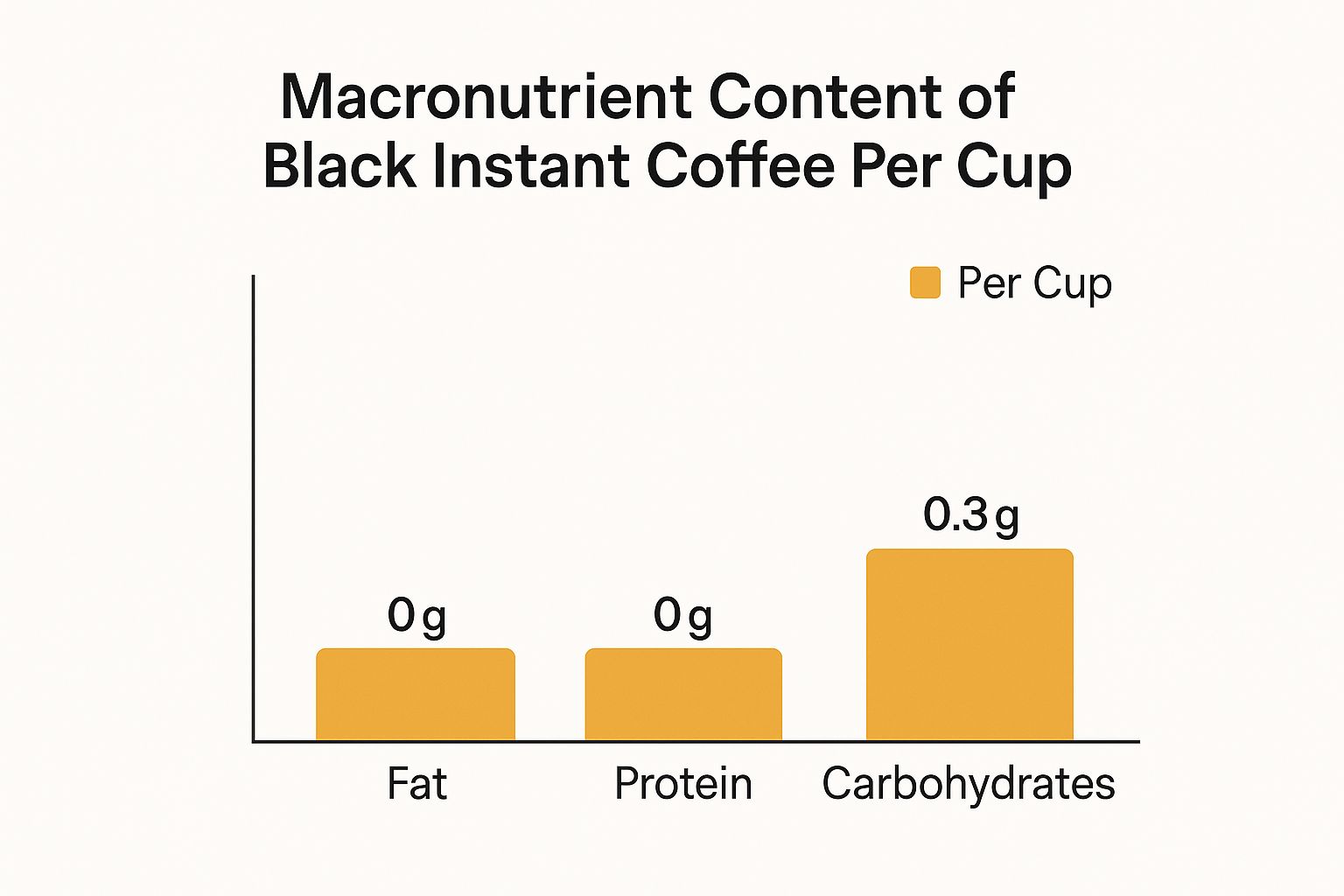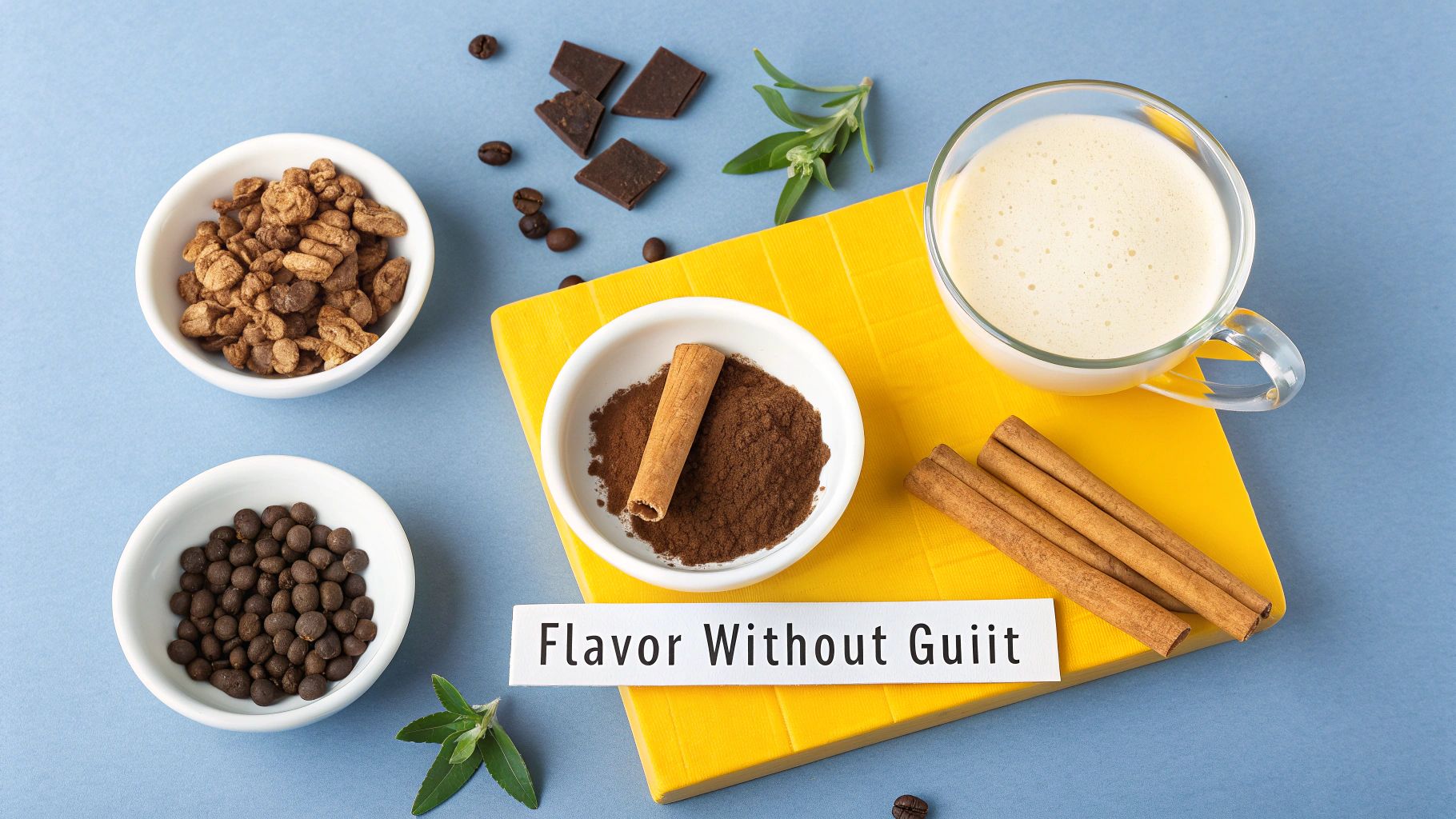So, how many calories are we really talking about with instant coffee? Let's get right to it.
On its own, a cup of plain, black instant coffee is incredibly light, containing just 2 to 5 calories. That's it. It’s practically nothing—about the same as a stalk of celery. The coffee itself is just dehydrated brewed coffee, so you're left with pure coffee solids without any of the fats or sugars that pack on calories.
The real story begins the moment you reach for the sugar bowl or the milk carton.
Where the Calories Really Come From

It’s easy to see why so many health-conscious people love instant coffee. You're starting with a nearly zero-calorie base, which is fantastic. But it's what we add to our coffee that completely changes the nutritional math. Think of black coffee as a blank canvas; the additions are the paint, and they can add up quickly.
This is the key to understanding your daily cup. The coffee isn’t the culprit—it’s the customizations.
To give you a clearer picture, here's a simple breakdown of how common additions can transform your morning brew.
Instant Coffee Calories At a Glance
| Coffee Preparation | Estimated Calorie Count |
|---|---|
| Plain Black Instant Coffee | 2–5 calories |
| With 1 Tsp Sugar | ~20 calories |
| With 2 Tbsp Whole Milk | ~20 calories |
| With 1 Tsp Sugar & 2 Tbsp Whole Milk | ~40 calories |
See how fast that happens? A single teaspoon of sugar quadruples the calorie count instantly.
This is actually great news. It means you have total control. If you love the pure, unadulterated taste of coffee, you can sip away guilt-free. And if you like it a little sweeter or creamier, you can make informed choices, which is something we dive into in our guide to making instant coffee healthier.
Why Plain Instant Coffee Is Nearly Calorie-Free
Ever wonder how instant coffee manages to be so incredibly low in calories? The secret is all in how it’s made.
Picture making a super-concentrated beef broth, simmering it for hours until all the rich flavor is extracted, and then gently evaporating every last drop of water. What you’d have left is the pure, flavorful essence. That’s pretty much the same idea behind instant coffee.
Coffee beans are roasted and ground, then brewed into a strong liquid concentrate. From there, all the water is removed using methods like spray-drying or freeze-drying, leaving behind just the soluble coffee solids. This clever process locks in the flavor and aroma but leaves behind anything that would add calories.
Because this process strips away the water and leaves only the soluble parts of the coffee bean, you end up with a base for your drink that has virtually no fat, protein, or sugar. The calories are so minimal precisely because the macronutrients that provide energy just aren't there in the final product.
Breaking Down the Macronutrients
When you look at the nutrition label on a jar of plain instant coffee, the numbers don't lie. The "big three" macronutrients—fat, protein, and carbohydrates—are what give food its calorie count. For black instant coffee, they're barely even there.
This little infographic paints a really clear picture of what’s in a typical cup of black instant coffee.

You can see it right there: zero fat and zero protein. The only thing present is a tiny trace of carbohydrates, which is what accounts for the two-to-five calories you might see listed.
This just goes to show that the coffee itself isn't the culprit when calories start to add up. Think of it as a clean slate, giving you total control over what you add to your mug without worrying about hidden calories in the coffee base.
How Add-Ins Dramatically Increase Calories

Starting with a nearly zero-calorie cup is one of the best things about instant coffee. But that beautiful blank canvas can quickly turn into a high-calorie creation without you even realizing it. The journey from a simple 5-calorie drink to a 200-calorie indulgence happens one splash, pump, or spoonful at a time.
It’s almost never the coffee itself that's the problem; it’s what we decide to put in it. Understanding exactly where those calories come from is the key to building a better cup that still tastes great.
Sugars and Syrups
This is usually the biggest offender. A touch of sweetness can bring out the best in coffee, but it's incredibly easy to underestimate how fast those calories add up.
A single teaspoon of regular table sugar tacks on about 16 calories. If you're a two-teaspoon person, you've just added 32 calories before even thinking about milk or cream.
The real calorie bombs, though, are the flavored syrups you see at coffee shops. A single pump of vanilla or caramel syrup can easily add 20 to 30 calories, almost all from sugar. Since many drinks use three or four pumps, you could be looking at over 100 extra calories from the syrup alone.
Milk and Creamers
That creamy, satisfying texture we all love also comes with a calorie cost, and it varies wildly based on your choice. Fat content is the name of the game here.
Let's look at how the most common options stack up:
- Whole Milk: A splash (about 2 tablespoons) adds around 19 calories.
- Half-and-Half: The same amount more than doubles the count to about 40 calories.
- Heavy Cream: This is the richest option, with just two tablespoons packing in a hefty 100 calories.
- Unsweetened Almond Milk: A fantastic low-calorie pick, adding only 5 calories for the same two tablespoons.
Don't forget about non-dairy and powdered creamers. The flavored and sweetened versions, in particular, can be surprisingly high in calories from hidden sugars and oils. A quick glance at the label is always a good idea.
Remember, every little thing adds up. A simple cup of instant coffee with two sugars and a splash of half-and-half can easily push past 100 calories, turning your morning ritual into a mini-snack.
To make it even clearer, here’s a quick look at how some of the most popular coffee additions compare side-by-side.
Calorie Impact of Common Coffee Add-Ins
This table gives you a straightforward comparison of common additions, helping you see exactly what you're stirring into your mug.
| Add-In | Serving Size | Average Calories |
|---|---|---|
| Granulated Sugar | 1 teaspoon | 16 |
| Flavored Syrup | 1 pump (~0.5 oz) | 25 |
| Whole Milk | 2 tablespoons | 19 |
| Half-and-Half | 2 tablespoons | 40 |
| Heavy Cream | 2 tablespoons | 100 |
| Unsweetened Almond Milk | 2 tablespoons | 5 |
Seeing the numbers laid out like this really highlights how a few small choices can make a huge difference in the final calorie count of your daily coffee.
Instant Coffee Calories vs. Other Brews
So, how does instant coffee stack up against your other morning go-to's when it comes to calories? Let's take a look.
https://www.youtube.com/embed/GcC_cxH-XZk
When you're just comparing the black coffee itself, the numbers are pretty much a wash. Whether you're making instant, using a drip machine, a French press, or even pulling a shot of espresso, a plain cup is going to land you somewhere in the ballpark of 2 to 5 calories. That's it.
Think of it this way: all these brewing methods are just different routes to the same destination. They each have a unique way of getting flavor out of the coffee beans, but the end result—before you add anything—is fundamentally the same. It's just coffee and water. So, from a calorie perspective, the brewing method for black coffee doesn't make much of a difference.
The real caloric chasm opens up when you pit a simple cup of instant coffee against the fancy, elaborate drinks you'd get at a cafe. A homemade instant coffee gives you a virtually calorie-free starting point, putting you in total control. A coffee shop latte, however, is a whole different beast.
From Simple Brew to Calorie-Dense Drink
The second you introduce steamed milk, sugar, and flavored syrups, the calorie count skyrockets. A typical 12-ounce cafe latte made with whole milk can easily pack 150 calories, and that’s before any sugar is added. Go for a mocha with its chocolate sauce and whipped cream, and you could be looking at over 300 calories.
The takeaway here is simple: it’s not the coffee, but what you put in it. A plain instant coffee and a decadent cafe mocha both begin with the same low-calorie coffee base. The huge difference in calories comes from all the extras—the milk, sugar, syrups, and toppings.
Here’s a quick breakdown to put it all into perspective:
- Black Instant Coffee: 2–5 calories
- Drip Coffee (Black): 2–5 calories
- Espresso Shot: ~3 calories
- Standard Cafe Latte (12 oz): 150+ calories
- Standard Cafe Mocha (12 oz): 290+ calories
This stark contrast drives home a point we cover in our complete guide to black coffee calories: your daily coffee calorie intake is almost entirely dictated by how you prepare it, not how you brew it. By starting with a simple base like instant coffee, you hold all the cards.
Enjoying Flavorful Low-Calorie Instant Coffee

Here's the great news: plain instant coffee is basically a zero-calorie drink. This gives you a blank canvas to create your perfect cup without straying from your health goals. It’s all about getting smart with your add-ins to pack in flavor, not calories.
When you think beyond the usual suspects like sugar and heavy cream, a whole world of delicious, low-calorie options opens up. You can easily whip up a satisfying coffee that feels like an indulgence every morning.
Smart Swaps and Flavor Boosters
Instead of automatically reaching for the sugar bowl, try some of these simple swaps to completely transform your daily coffee:
-
Spice It Up: A dash of cinnamon or a pinch of nutmeg adds a wonderful warmth and depth. These spices have a way of tricking your brain into tasting sweetness for almost zero calories.
-
Go for Unsweetened Cocoa: Craving a mocha? Stir in a teaspoon of unsweetened cocoa powder. It adds a rich, chocolatey flavor for only about 10 calories, along with a nice antioxidant boost.
-
Choose a Smarter Milk: For that creamy texture, a splash of unsweetened almond milk is a game-changer, adding as few as 5 calories. That’s a huge drop from the 40+ calories you might get from half-and-half.
The goal is to add flavor, not just empty calories. By focusing on spices, unsweetened additions, and smart milk alternatives, you enhance the coffee's natural notes without relying on sugar.
If you’re hunting for more inspiration, we've got a whole guide on how to make instant coffee taste better that’s packed with more expert tips.
At the end of the day, managing your instant coffee calories comes down to making mindful choices. With just a few simple tweaks, you can brew a rich, satisfying cup that fits perfectly into a healthy lifestyle.
Common Questions About Instant Coffee Calories
Even with the basics covered, a few common questions always seem to pop up about instant coffee and its calories. Let's get those cleared up so you can feel good about what you're drinking.
Does the Brand Actually Matter for Calories?
In a word, no—not really. When you're talking about pure, unadulterated black instant coffee, the calorie count is going to be incredibly low, typically somewhere between 2 and 5 calories a cup, no matter which brand you buy.
Sure, one company might use a different type of bean or a slightly different drying process, but those tiny variations don't really move the needle on the final calorie count. The core stuff—the dehydrated coffee itself—is consistent. Where you'll see a huge difference is in those 3-in-1 packets that come pre-loaded with sugar and powdered creamers. That's a different story entirely.
When you're picking a plain instant coffee, base your choice on taste, not calories. The nutritional basics are pretty much the same across the board.
What About Caffeinated vs. Decaf?
This is another area where things are simpler than you might think. When it comes to instant coffee calories, the difference between your regular and decaf options is almost nothing.
The process of decaffeinating coffee just removes the caffeine. It doesn't touch the coffee solids that contain those few calories. So, whether you're reaching for a morning jolt or a mellow evening cup, you can expect the same super-low calorie count. The choice here is all about your caffeine preference, not your diet.
How Do I Keep Track of Calories in My Own Coffee Creations?
It's actually pretty straightforward to track the calories in the coffee you make at home. Just start with a baseline of 5 calories for the black instant coffee itself.
From there, it's just simple addition based on what you add.
- Check the nutrition label on your milk or creamer and measure how much you pour.
- Do the same for sugar, counting by the teaspoon, or syrup, counting by the pump.
- Don't forget to account for any fun extras, like a sprinkle of cocoa powder or a dollop of whipped cream.
If you're serious about tracking, a food logging app can be your best friend. You can plug in your go-to recipe once and then log it with a single tap every day.
Ready to start with a truly exceptional, organic instant coffee that makes the perfect low-calorie foundation for any drink? Cartograph Coffee delivers amazing flavor without anything extra.